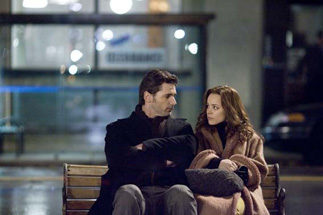Book vs. Movie: The Time Traveler's Wife
By Russ Bickerstaff
August 18, 2009
In this corner: the Book. A collection of words that represent ideas when filtered through the lexical systems in a human brain. From clay tablets to bound collections of wood pulp to units of stored data, the book has been around in one format or another for some 3,800 years.
And in this corner: the Movie. A 112-year-old kid born in France to a guy named Lumiere and raised primarily in Hollywood by his uncle Charlie "the Tramp" Chaplin. This young upstart has quickly made a huge impact on society, rapidly becoming the most financially lucrative form of storytelling in the modern world.
Both square off in the ring again as Box Office Prophets presents another round of Book vs. Movie
The Time Traveler's Wife
A few years back, Chicago-based writer Audrey Niffenegger wrote a science fiction book that was published and marketed as non-genre fiction. It was her first novel and it became a best-seller. The premise is simple: a man has a genetic disorder that causes him to travel through time. Along the way, he frequently runs into a girl at various stages in his life. This girl is destined to be his wife. The episodic novel plays on a lot of different ideas about the romantic love that ties two people together. The idea was so simple and primal that it had gotten a lot of attention before it ever saw commercial bookshelves. Before it was even published, Brad Pitt and Jennifer Aniston's Plan B Entertainment had optioned the film rights to the novel. Over half a decade later, the film makes it to the screen in a film starring Eric Bana and Rachel McAdams. How does the work of a first-time author stack-up to a big-budget Hollywood adaptation?
The Book
From the first page, Niffenegger's Time Traveler's Wife establishes itself with a non-traditional, somewhat non-linear plot structure. We are seeing the story from two perspectives: that of inadvertent time traveler Henry and Clare, the woman he loves.
The concept of time travel as an affliction has appeared elsewhere before, but never in such vivid emotional clarity as Niffenegger manages here. Over the course of the novel, we see that Henry suffers from a genetic disorder that causes him to disappear and reappear at some other point in time. The inadvertent time travel happens only within only those places and times that have meaning for him ...or something like that. Though there is a great deal of explanation about Henry's condition, it exists in the novel as a phenomenon that science is only beginning to understand, so precisely why he ends up where he does at given times is never fully explained. And there's never really a very satisfactory explanation for why traveling robs him of his clothes...whenever he appears in a different time, he is nude.
This initial vulnerability of passing through time and finding himself naked causes a great deal of stress. Suddenly naked and often in a public place, Henry has mastered the art of picking locks and picking pockets in order to right himself as quickly as possible and adjust to where he is. This adds a particularly dark survival aspect to the character. There's a particularly interesting scene in the novel where an adult Henry is teaching himself to pick locks and pockets as a child. It is only later that he realizes that the man who is teaching him these things is, in fact, himself.
Continued:
1
2
3




